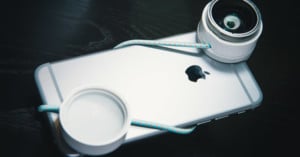
Extreme Eye Photos That Look Like an Aerial View of an Alien Landscape
A photographer battled to get these extreme close-up photos of eyes that look like an otherworldly landscape.

A photographer battled to get these extreme close-up photos of eyes that look like an otherworldly landscape.

A photographer in Florida has fulfilled her dream and has launched a photo studio with one specific purpose: to capture macro shots of customers' eyes.

The world of macro photography is full of fascinating subjects, but eyes and irises have got to be among the most mesmerizing ones. As with most captivating subjects, capturing it can be quite a challenge.

IRIS is a new photo booth that's designed to shoot "professional" portraits of professionals for only $20. Instead of looking like typical photo book snapshots, the portraits are supposed to look like they were shot by a headshot photographer with studio lighting.

Photographer and artist Fabian Oefner is known for his creative work with paint, oil, and even petrol. He's a master of finding beauty in chemistry, and capturing that beauty through his camera lens. Oil Spill, his most recent project, is no exception.

If there's one piece of technology that I love, it's my phone. And as a photographer, always having a camera is convenient, occasionally saving myself from missing that once in a lifetime shot.
However the worst part is the fixed focal length of my phone's camera.

Love someone who loves photography, and planning to pop the question soon? Check out this homemade ring box Matt Chalker made for his photographer girlfriend recently. It opens and closes like the aperture on a camera, and it took about 50-60 hours to make.

One of the more interesting stories we ran across this weekend was an initial update from a small group of scientists who claim to have successfully extended human vision into near infrared. Their data seems to show that they have, indeed, managed to do this simply by altering their subjects' diet by restricting vitamin A1 and supplementing with A2 in order to create a certain protein complex. You can read more about this here.
The results seem exciting, mind-blowing even. But retinal neuroscientist and photographer Bryan Jones begs to differ, and he has been kind enough to let us reprint his full rebuttal below.

As smartphones have gotten smaller and smaller, the need for the cameras inside of them to shrink has become more pressing. One area where there's a lot of room for improvement is in the traditional mechanical aperture.
As we begin to hit the physical limit of the overlapping blades, researchers at the University of Kaiserslautern have designed an exciting new ‘micro iris’ that uses small chemical rings rather than a physical blades, dramatically shrinking the size of the aperture components in the camera.

Using the human eye to control cameras isn't a new idea -- Canon used to offer eye-controlled focusing in its SLRs -- but designer Mimi Zou's Iris concept camera takes the concept one step further by having the camera be entirely controlled by the eye. Shaped like a lens, the photographer uses the camera by simply looking through it. Focusing, zooming, and snapping photos are done by looking, narrowing/widening the eyes, and blinking (respectively).

Here’s a camera shop promo that features the Nikon D4 filmed with a Phantom Gold high speed camera. It …

Here’s a slow motion video showing a closeup look at the human eye, our amazing biological lens (and sensor).

Instructables user art.makes has a tutorial on how you can make a pair of paper iris glasses with adjustable apertures. You could definitely build upon the idea to make each side more like a camera lens (e.g. adding barrels, f-stop values) -- perhaps as part of a geeky Halloween costume?

Bryce Bell of cardnetics created this business card design that features a built-in …